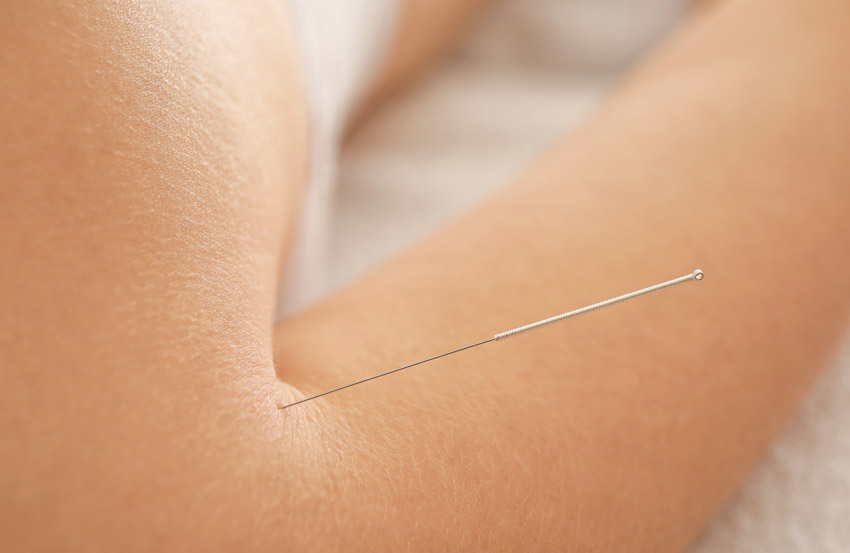
Acupuncture is effective for the prevention of neurotoxicity caused by oxaliplatin-based chemotherapy. In research conducted at the Second Affiliated Hospital of Anhui University of Chinese Medicine, acupuncture reduced neurotoxicity rates to 30.00%. Another group receiving intravenous B12 (mecobalamin) therapy yielded a 36.84% neurotoxicity incidence rate. Both of these approaches to controlling adverse reactions outperformed chemotherapy without additional care, which produced a 78.95% neurotoxicity incidence rate. [1]
Traditional Chinese medicine (TCM) clinical syndrome scores were measured for all patients in the study. Acupuncture produced an 85.00% total effective rate in improving TCM scores, mecobalamin produced a 63.16% total effective rate, and the chemotherapy control group without any intervention produced a 52.63% total effective rate. Based on the data, the researchers conclude that acupuncture treatment reduces the occurrence of oxaliplatin neurotoxicity while significantly improving the TCM clinical syndrome scores of patients receiving chemotherapy.
Oxaliplatin is a third-generation platinum anticancer drug. It is mainly used for first and second-line treatment of advanced colorectal cancer and for adjuvant therapy after surgery. While achieving good clinical results, the downside is that it can cause acute and chronic neurotoxicity. It was reported that 89% of patients develop neurological symptoms after administering oxaliplatin, mainly in the peripheral nervous system. [2] In severe cases, it can affect patients' daily lives, including walking, writing, sense of touch, diet, emotions, and sleep, leading to a decline in quality of life. Due to possible side effects, patients may have reduced chemotherapy doses or discontinued treatment, resulting in poor compliance and prognosis.
A total of 58 patients were treated and evaluated in this study. Patients received oxaliplatin-based chemotherapy and were randomly divided into an acupuncture group, a mecobalamin group, and a chemotherapy control group with 20, 19, and 19 patients in each group respectively. For the B12 group patients, 0.5 mg mecobalamin was administered through intravenous injections, once per day, for three days as one treatment course. Mecobalamin is a form of vitamin B12, often for the treatment of neuropathies.
The statistical breakdown for each randomized group was as follows. The acupuncture group had 13 males and 7 females. The average age in the acupuncture group was 57.10 years. The western drug group had 14 males and 5 females. The average age was 57.63 years. The chemotherapy only group had 15 males and 4 females. The average age in the chemotherapy only group was 54.47 years. There were no significant statistical differences in terms of gender, age, and other demographics relevant to patient outcome measures.
Oxaliplatin-induced neurotoxicity mainly manifests as sensory disturbances or abnormalities in the limbs and skin. In TCM, it falls under the Xue Bi (blood impediment) class of disorders. The treatment principle is to dredge the meridians and channels using either the Ping Bu Ping Xie (mild attenuating and tonifying) or Xie (attenuating) manipulation techniques at the early stage, when there is only sensory nerve impairment. For later stages when motor nerves are effected, the treatment principles shifts toward nourishing the blood, softening the tendons, and tonifying the kidneys and liver. Either the Ping Bu Ping Xie (mild attenuating and tonifying) or Bu (tonifying) manipulation technique can be applied in this stage. All patients received administration of the following primary acupoints:
- LI11 (Quchi)
- PC6 (Neiguan)
- LI4 (Hegu)
- SP10 (Xuehai)
- ST36 (Zusanli)
- SP6 (Sanyinjiao)
A secondary set of acupuncture points was added dependent upon individual symptoms. For numbness of fingertips or toes, the following acupoints were needled using the three edge needling technique:
- EX-UE11 (Shixuan)
- EX-LE12 (Qiduan)
For motor dysfunction or muscle atrophy, the following acupoints were added:
- GB34 (Yanglingquan)
- Shu points of the hand and foot yangming channels
For phlegm and dampness, the following acupoint was added:
- ST40 (Fenglong)
Acupuncture treatment commenced with patients in a supine position. After disinfection of the acupoint sites, a 0.30 mm × 25 mm or 40 mm disposable filiform needle was inserted into each acupoint. For Neiguan and Hegu, the needle was inserted perpendicularly to a depth of 0.5–0.8 cun and applied with the mild attenuating and tonifying manipulation technique. For Quchi, Xuehai, Zusanli, and Sanyinjiao, the needle was inserted perpendicularly to a depth of 1–2 cun and stimulated with the tonifying technique. For all acupoints, the manipulation techniques were applied every 10 minutes during the 30-minute needle retention time. Acupuncture sessions were administered once per day, 6 times per week as one treatment course.
The results indicate that acupuncture is effective for reducing oxaliplatin-induced neurotoxicity. Acupuncture can be utilized in an integrative model for cancer patient care and prevent neurotoxicity associated with chemotherapy. Based on the findings, we would like to see an additional study to examine the benefits of combining acupuncture and mecobalamine into an integrated treatment protocol for possible additive or synergistic effects.
References:
[1] Wu Y, Zeng YL, Leng YL. Clinical Observation of Acupuncture Prevention and Cure Effect on the Nitrobenzene Induced Neurotoxicity in the Circuit of Chemotherapy Period [J]. Clinical Journal of Traditional Chinese Medicine, 2018, 30(04):725-728.
[2] Pachman D R, Qin R, Seisler DK, et al. Clinical Course of Oxaliplatin-Induced Neuropathy: Results from the Randomized Phase Ⅲ Trial N08CB (Alliance) [J]. J Clin Oncol, 2015, 33 (30): 3416-3422.

